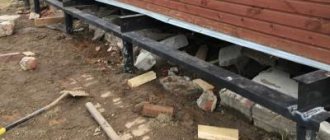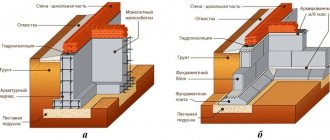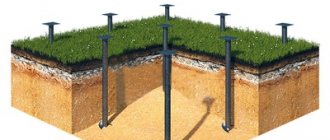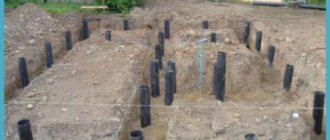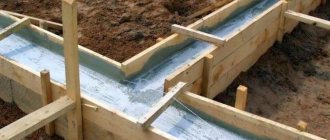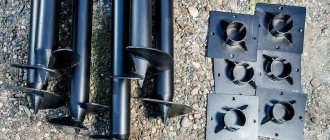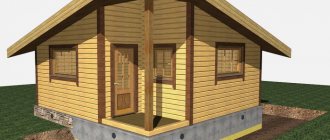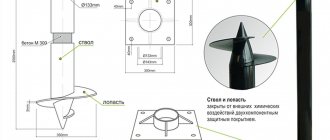Many builders, when starting to build a foundation, are faced with a big problem. Are they not satisfied with the type of soil? Maybe there is a lack of funds for construction? It's all about choosing the foundation for the house. At the moment, there are many different variations of how you can arrange the foundation. All of them differ in load-bearing capacity, appearance, design and device technology.
In addition, each foundation has its own advantages and disadvantages. The most popular options are considered to be strip and column foundations. They have won over many developers over the years. At the same time, there are adherents of both the first option and the second. Some defend their representative, others defend theirs. How to figure out which foundation is better, pile or strip?
To find out the answer to this question, let's rationally compare these foundations, find out their positive and negative aspects, and also find out consumer reviews. So, you can make your choice.
Foundation on stilts
First, let's pay attention to the pile foundation. It is significantly different from the tape one in its design. Piles are used as supports, which characterize the type of foundation. They are driven, screwed or inserted into the ground around the perimeter of the building. The main emphasis is on the corners of the building and places where the load is greatest. For small buildings, a foundation made of piles can follow the contour of the building, but for massive structures a solid foundation is made, as can be seen in the photo.
Since it is the piles that characterize the foundation, let’s talk about them in more detail. We mentioned that the device can be of different types (driven, screw, bored). It all comes down to the type of piles. There are several types of products that differ in material:
- Wooden piles.
- Made of metal.
- Made of concrete.
- Made of reinforced concrete.
Foundation construction method
If we talk about the screw type, then metal piles are made, the end of which has blades (notches). Thanks to them, the product can be easily screwed into the place you need. In this case, the work is performed both with your own hands and with the help of a special tool. It is enough to dig a small hole and start screwing the pile into the ground strictly perpendicularly.
The scoring option speaks for itself. Piles with a sharp tip and a blunt end are used. Using special equipment, the products are driven into the ground to the required depth.
A bored foundation is constructed differently. For this, wells are made in advance, a hollow pile is installed in them, everything is reinforced and filled with concrete.
After all the piles are installed in place, they are leveled horizontally and the strapping is performed. This foundation has become popular due to the fact that it has increased load-bearing capacity. In addition, such a base can be used on any type of soil, regardless of its complexity.
Note! Factories that specialize in the production of piles have begun to produce supports that have increased strength.
For example, standard screw piles have a wall thickness of 4 mm. For problematic soil, this indicator is more than enough. But now you can buy supports that have a metal wall thickness of 6.5 mm. This has expanded the range of applications of this type of foundation, making it indispensable in industry.
The main factor that speaks in favor of this type of foundation is the ability to build a foundation on problematic soil. What are they? Clay soil, loamy, peaty and marshy. It is not recommended to build a reinforced concrete foundation with such soil. And if you do this, then a reliable design will cost you much more. It turns out that for a lower price of a pile foundation, you get a high-quality foundation.
Soil features
There are several types of soil.
- Stony and rocky soils. They are considered the best option for construction, as they are characterized by strength, frost resistance, and resistance to water. However, digging a pit or driving piles into such soil is not easy. The way out of the situation is usually leader drilling - preparing a well into which a support is then driven or lowered.
- Clayey. They are characterized by greater heaving (they become saturated with water and acquire a “heaving” state, swelling when freezing). Clay soils are not very dense and therefore subject to deformation. They are divided into clay, loam, and sandy loam.
- Sandy. In general, this type of soil can be classified as non-heaving, since sand allows water to pass through without being subject to deformation and can be compacted well. This soil has several varieties. These are gravelly soils (coarse sand), soils made from medium sand and “silty” soils (based on fine sand, which is similar in characteristics to clay).
- Organic. These include silty and peaty soils. They are the most unsuitable for construction because they are friable and have a high groundwater content.
To summarize, we can say that a strip foundation requires stronger, denser, non-water-saturated soil. This type of foundation is not recommended for use on relief soils, during construction on mountain slopes, or near water bodies.
The pile method (depending on the chosen technology for driving in supports) can be located on almost any type of soil - saturated with moisture, mobile, clayey and even organic. However, on too dense rocky soils, an attempt to drive a pile is fraught with its deformation. It is also impossible to use the pile-screw method of installing supports. The way out of the situation would be to install a strip foundation or preliminary leader drilling of wells for pressed supports.
However, on solid but not rocky soils, you can try to organize a pile foundation using the technique of washing away the soil. For this purpose, a shaft is also prepared into which the support is lowered (as far as possible). After this, water is supplied under pressure into the space between the support and the shaft. Flowing down, it softens the soil and also helps reduce friction between the structure and the soil.
We invite you to familiarize yourself with reinforcement for the foundation - calculation of reinforcement for the foundation of a house
Clay soil
When the types of soils have been considered, and it has been established on what soil the construction is planned, you can begin to select the optimal type of foundation.
Based on the type of construction, foundations are of the following types: strip, pile, block, columnar.
Depending on the material used, there are: reinforced concrete, stone, and wood.
The most widely used foundations are strip foundations and pile foundations. The following describes in more detail the features of these foundations, after analyzing which you can determine which foundation is better - strip or pile in your particular case.
Strip foundation
The strip foundation is named due to its special design: along the entire perimeter of the designed structure and under all its supporting walls, the foundation is laid in the form of a reinforced concrete strip, which forms a closed contour.
Strip foundation
The type of strip foundation, in turn, is divided into two subtypes: monolithic and prefabricated. They differ in the way they are constructed.
When installing a monolithic type of strip foundation, directly at the installation site of the foundation, the reinforcement frame is knitted and filled with concrete. This ensures the integrity of the foundation (solidity).
When installing the prefabricated type, reinforced concrete blocks are attached to each other thanks to reinforcement and cement.
The strip foundation also differs in the depth of its placement (above or below relative to the depth to which the soil freezes) and can be: deeply buried and shallow. For example, a monolithic heavy building is built on a deep foundation, and light wooden structures are built on a shallow foundation.
As for compatibility with types of soil, the features are as follows:
- Prefabricated strip foundations are not recommended to be combined with heaving and water-saturated soils, as well as on slopes;
- strip monolithic foundation is suitable for almost all types of soil;
- It is strictly forbidden to build a strip foundation on organic soil (for example, peat bogs).
The advantageous aspects of a strip foundation include:
- versatility (suitable for any building);
- ease of installation of a strip monolithic foundation (you can install it yourself);
- strip monolithic foundation is very airtight;
- a prefabricated strip foundation is an excellent solution if the building is planned to have a basement or ground floor.
The disadvantages of strip foundations include:
- the cost of materials for a strip foundation is higher than for a foundation on piles;
- massiveness of the prefabricated strip foundation, labor intensity when deepening the foundation.
Pile foundation
Pile foundations are called foundations, which are a structure of piles that are connected at the top by a beam or grillage slab (both concrete and reinforced concrete slabs are used).
A pile is a rod that is driven into the ground to transfer the load from the structure. Piles can be reinforced concrete, metal, wood, or combined.
According to the method of deepening into the ground, piles are:
- Driving: driving is carried out using special machines (called pile drivers) or special vibration-pressing units. Such piles can only be used if the area is not built up and there are no structures nearby whose foundations could be damaged.
- Driven: a hole is drilled or punched in the ground into which concrete is poured. To ensure the reliability of foundations on subsidence soils, the bottom of the well is expanded by a micro-explosion, and after pouring concrete, a pile appears to have a base.
- Screw: at the end of the reinforced concrete shaft there are special blades, with the help of which the pile is screwed into the ground.
Regarding compatibility with types of soil, it should be noted that pile foundations can be used on all complex soils (loose, water-saturated) and on organic soils (for example, peat).
Model of deepening a pile-screw foundation into the soil
At the same time, you should not miss that dense, rocky and rocky soils are very difficult to install a pile foundation, and it is generally impossible to use a pile-screw foundation.
The advantages of a pile foundation, which outweigh the disadvantages, include:
- reliability;
- cost-effectiveness (any type of pile foundation in terms of labor costs and the cost of materials is cheaper than all other foundations, including strip foundations);
- high strength;
- long service life;
- simplicity and speed of installation of screw piles.
The disadvantages of a pile foundation include:
- it is impossible to check damage to the pile;
- for screw piles, corrosion is a real scourge;
- It is impossible to build a basement.
In conclusion, we note that for sloping areas and complex terrain, a combined foundation (strip-pile) is best suited.
Combined pile-strip foundation
Pros and cons of a pile foundation
So, in order to have a complete picture, let's summarize everything and find out what are the advantages of this type of foundation.
- Low cost. You will spend 30% less money on constructing a pile foundation than on constructing a reinforced concrete structure (if we talk about loose and unstable soil).
- Short construction time for the finished structure. The work is done quickly and without much labor. In addition, no special equipment is required (for driving type only). If you need to build your own small house or barn, then everything can be done quickly and with your own hands.
- An ideal option for constructing a building on problematic soil. We are talking about swamp, clay, etc.
- Safety and durability of the base. If the technology of the device is followed, it can last up to 200 years.
- Compared to a strip foundation, no trenching work is required. And you won’t have to bother with concrete. Thanks to this, the work is simple and fast.
- You can start work at any time, even in winter. It is enough to clear the area of snow and begin the process.
- If there are large differences in height on the site, this is not a problem for a pile foundation.
- High strength and ability to withstand heavy loads.
As you can see, there are really a lot of advantages and all of them are quite significant. Does it have any disadvantages? Of course, not a single thing can do without them. The same applies to pile foundations. They are small, but they are there, so pay attention to them.
- If you do not have sufficient knowledge, you can buy low quality piles. And this will lead to the fact that it is not worth talking about the durability of the constructed foundation. After all, metal can rust and reinforced concrete can crumble. This can lead to tragic consequences.
- Pile foundations cannot be used on rocky soil. The blades may break, and it will be quite difficult to achieve the desired depth. As a result, a shallow, unstable foundation is unsuitable for construction.
- It is impossible to build a basement under the building. The same goes for the garage.
- High labor costs to insulate the free space under the floor and decorate it.
If you believe the reviews, most people are satisfied with the quality of this type of foundation.
Strip foundation type
This is a massive reinforced concrete structure. It has an impressive weight, and the device will require a lot of effort. What is this type of foundation? The photo shows what it looks like.
This continuous strip follows the contour of the entire building, including load-bearing walls and interior walls. This is a closed structure, which is made of concrete mortar reinforced with reinforcing bars. But, a strip foundation can be built from several types of material:
- brick;
- concrete;
- concrete blocks.
The entire load is transferred to the belt and distributed over the ground. A special feature of the foundation is its high load-bearing capacity. It is suitable for both small houses and impressive structures.
Foundation construction method
To build such a foundation, you need to work hard with earthworks. The fact is that to fill the tape you need to dig a suitable pit that follows the contour of the house. Moreover, it can have a width ranging from 40 cm, and a depth from 50 cm and above. For difficult soils, a trench is made 1.5 m deep.
The next stage is the installation of a sand cushion to prevent soil erosion by water. Sand and gravel are compacted (each layer is at least 10 cm), lathing is made on top, reinforcing mesh is installed and everything is filled with concrete. The characteristic thing is that much more money, effort and time are needed to erect the structure. In addition, it is not recommended to use it for swampy or clay soil.
When is it advisable to use a pile-grillage foundation?
Installation of piles and strapping beams is a labor-intensive and financially expensive process. In what cases will material and resource losses be well spent:
- At high groundwater levels;
- With loose and weak foundations of sand, clay and loam;
- For the construction of wooden and foam concrete houses.
For lightweight houses with frame-panel walls, a grillage made of channel or wooden beams is suitable. For heavier structures you will need monolithic or precast concrete.
A pile-grillage foundation for a house made of aerated concrete is simply a godsend: it will withstand the load of even a 2-story house and will save your budget compared to choosing a foundation of a different structure.
Pros and cons of strip foundations
Now let's begin to consider the advantages and disadvantages of this type of foundation.
- One of the main advantages of the foundation is the ability to build a basement and garage. Not only can communications be hidden in this room, but heat loss from the house itself is reduced. Yes, and the space for storing the car is freed up.
- Despite the high labor costs, you can do all the work yourself. During the entire process, the only mechanical tools you will need are a concrete mixer and a vibrating unit. Everything else is done manually, without specialized equipment.
- High strength, characteristics, and, accordingly, long service life. If installed correctly, the foundation will last at least 150 years.
- A good indicator of resistance to the negative effects of groundwater.
Despite the demand for this type of foundation, it has its obvious disadvantages:
- high labor costs for excavation work;
- long period of the entire process. Not only does it take a long time to dig a trench, but also to construct the formwork and wait a month for the concrete to dry;
- The foundation must be poured immediately to avoid the formation of joining seams. If they are allowed to occur, the strength of the foundation is significantly reduced. It is important to achieve a monolithic design;
- high cost, this also applies to materials, means and effort;
- Strip foundations are not suitable for all types of soil.
If we take into account reviews from developers, many note its reliability and long service life. However, not everyone is happy that they have to spend a lot of time on the entire process, from digging a trench to waterproofing.
